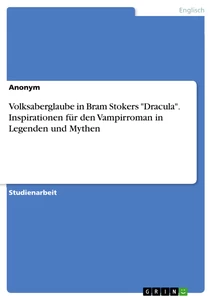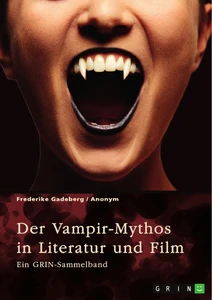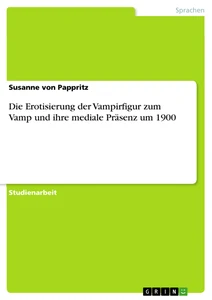<b>[openpublishing template="presentation" get_by_id="458182"] : </b></br>https://api.openpublishing.com/resource/v2/document.458182[:basic,non_academic.realm_genres.*]&cache=yes
<b>[openpublishing template="presentation" get_by_id="1430970"] : </b></br>https://api.openpublishing.com/resource/v2/document.1430970[:basic,non_academic.realm_genres.*]&cache=yes
<b>[openpublishing template="presentation" get_by_id="1453580"] : </b></br>https://api.openpublishing.com/resource/v2/document.1453580[:basic,non_academic.realm_genres.*]&cache=yes
First things first:
- The gothic novel was published in 1897 in Victorian England
- Classic vampire traits such as pale skin, invisibility in mirrors, and an aversion to garlic and sacred symbols can be found
- The main themes of the novel are gender, sexuality and illness
In 1897, Bram Stoker published his epistolary novel “Dracula” and thus significantly shaped the general concept of vampires. Although it wasn’t the first book about the legendary bloodsuckers, it remains the most iconic one to this day, thanks in no small part to Stoker’s clever combination of fairy tales, legends and the conventions of horror literature.
The character of Count Dracula is based on the 15th century Wallachian count Vlad III, also known as Vlad the Impaler or Vlad Dracula, who was considered a particularly cruel ruler. He was given the name “Dracula” because his father Vlad II, who belonged to the Order of the Dragon, was known as Vlad Dracul. The suffix -a means “son of”, so Vlad Dracula literally means “Vlad, son of Dracul”.
Summary
The book begins with travel diary entries by Jonathan Harker, a lawyer who is on his way to Transylvania to conclude the real estate contract for an estate in England with Count Dracula.
Despite warnings from the local people, he finally arrives at Dracula’s Castle. At first, the count seems like an older, very polite and well-educated man, but this image changes as soon as Jonathan realizes that he is trapped in the castle and gradually discovers his host’s supernatural abilities.
One night, despite the Count’s explicit warning, he wanders through the castle and is attacked by three vampire women. The Count “rescues” him at the last minute, as he wants him for himself, but shortly afterwards disappears to England on the ship Demeter with 50 boxes of Transylvanian soil. Jonathan manages to escape from the castle with the last of his strength.
In Whitby, England, Lucy Westenra, the best friend of Jonathan’s fiancé Mina Murray, has received three marriage proposals. One from the young doctor and head of the psychiatric institution Dr. John Seward, one from the American Quincey Morris and one from the English aristocrat Arthur Holmwood, who she finally chooses to marry.
After the Demeter docks in Whitby with a missing crew and a dead captain, Lucy begins to sleepwalk. One night, Mina finds her in the city’s cemetery and sees a pair of glowing red eyes bending over the young woman. A few days later, Mina receives the news that Jonathan has turned up in Budapest, so she decides to travel there to take care of her fiancé.
Lucy falls ill after the incident at the cemetery. She is very pale, anemic, and has two small wounds on her neck. Dr. Seward, who takes care of her, soon calls his old teacher and friend Professor Abraham van Helsing from Amsterdam for help. As soon as he arrives in Whitby and examines Lucy, he orders that fresh garlic flowers be placed in her room every night to protect her. This remedy helps until Lucy’s mother throws the flowers out of the window one night, unaware of their effect. Lucy is immediately attacked by Dracula again and loses so much blood that a blood transfusion is necessary. This happens several times until on the last night of her life, Dracula breaks through the window in wolf form. In the process, he scares her weak-hearted mother to death and sucks the last drop of blood out of the weakened Lucy.
Lucy wakes up as a vampire after her death and starts attacking children. Various newspaper articles appear that refer to her as the “bloofer lady” (= beautiful lady, according to the children). Van Helsing convinces Dr. Seward, Arthur Holmwood and Quincey Morris that Lucy has awakened as an undead and must be killed, so the four of them make their way to her tomb and perform a vampire killing ritual. This consists of driving a stake through the heart of the monster while it is sleeping, cutting off its head and stuffing its mouth with garlic. After this is done, the men swear to destroy Dracula.
After Mina and Jonathan, now married, return to England, they join the hunt for Dracula. Together with Van Helsing, Mina collects diary entries and letters to learn as much as possible about the vampire. However, he is onto the team and communicates with his loyal servant Renfield, who is housed in the psychiatric institution where the others are also sleeping. He grants Dracula entry the asylum and he attacks Mina over the course of several nights. Mina’s fate of becoming a vampire after her death seems to be sealed. The only way to prevent this is to destroy Dracula. To do this, the boxes of Transylvanian soil that Dracula needs to regenerate his power must first be rendered useless with sacred wafers. After this is done, Dracula is forced to flee back to his homeland.
The team travels to Transylvania, and once there, Mina and Van Helsing head to Dracula’s castle before he arrives to kill the three vampire women.
Jonathan, Arthur, Quincey and John follow Dracula on his journey. On the last stretch to the castle, they manage to overpower Dracula’s wagon. They kill the vampire by cutting off his head and piercing his heart with a knife, causing it to crumble into dust. Unfortunately, Quincey is fatally injured and dies, but this is the end of Count Dracula’s haunting.
The most important characters
Count Dracula
- Century-old vampire and Transylvanian nobleman
- Invisible in mirrors
- Abilities: superhumanly strong, can morph into bat, wolf, dog and fog
- Weaknesses: garlic, religious symbols, can only enter houses by invitation
Professor Abraham van Helsing
- Physician, philosopher and metaphysician
- Knows a lot not only about modern medicine, but also about superstitions and folk remedies
- Main antagonist of Dracula
Dr. John Seward
- Young doctor
- Head of the psychiatric institution
-> Renfield: Patient, his goal is to consume as many living beings as possible, Dracula’s servant
- Former student of Van Helsing
- Works with Van Helsing against Dracula from the beginning
Jonathan Harker
- Lawyer
- Visits Count Dracula on behalf of his company
- First victim of the vampire
- Fighter against Dracula
Mina Murray
- Jonathan’s fiancée, later wife
- Lucy’s best friend
- Heroine of the book: embodies purity, innocence and Christian faith
- One of the main players in the fight against Dracula
Lucy Westenra
- Pretty, lively young woman
- Is turned into a vampire
- Is rescued by Van Helsing and the others after her “death”
Main themes and possible interpretations
Gender and sexuality
- Seduction and desire (bite, beautiful vampire women)
- Dracula is equally interested in Jonathan as well as Mina and Lucy
- Corruption of “English femininity”
- Mina and Lucy as “New Women”: Mina as a Victorian woman and heroine, Lucy as a fallen and corrupted woman
- Fight against Dracula as a fight for control over women’s bodies
Illness
- Paranoia about diseases in Victorian England
- Vampirism similar to a sexually transmitted disease
- Illness is brought to England by strangers -> “invasion literature”
- Mentally ill person (Renfield) as an obsessed helper of evil
Special recommendation: Dracula Daily is a newsletter that allows you to read Dracula “as it happens”.
You get an e-mail on the days when there are diary entries and letters.
Our recommendations:
Frequently Asked Questions
When does "Dracula" by Bram Stoker take place?
The figure of Count Dracula is based on the Wallachian prince Vlad III, also known as Vlad the Impaler or Vlad Dracula from the 15th century, who was considered a particularly cruel ruler.
Where did Bram Stoker write "Dracula"?
The novel was published in 1897 in Victorian England.
Bram Stoker significantly shaped the general idea of vampires with his epistolary novel “Dracula”.
Although it was not the first book about the legendary bloodsuckers, it remains the most iconic to this day.
How does "Dracula" by Bram Stoker end?
In Transylvania, the team travels to Dracula’s Castle.
They overpower Dracula’s transporter, follow him, and finally kill Dracula by decapitation and stabbing him in the heart.
Quincey dies in the process, but ends the haunting of Count Dracula.
Sources:
- Stoker, Bram. 1897. Dracula. The Penguin English Library.
- Popular superstition in Bram Stoker’s “Dracula”.
- Female Characters in Bram Stoker’s “Dracula” | GRIN
- Wikipedia article: Wikipedia: Dracula




